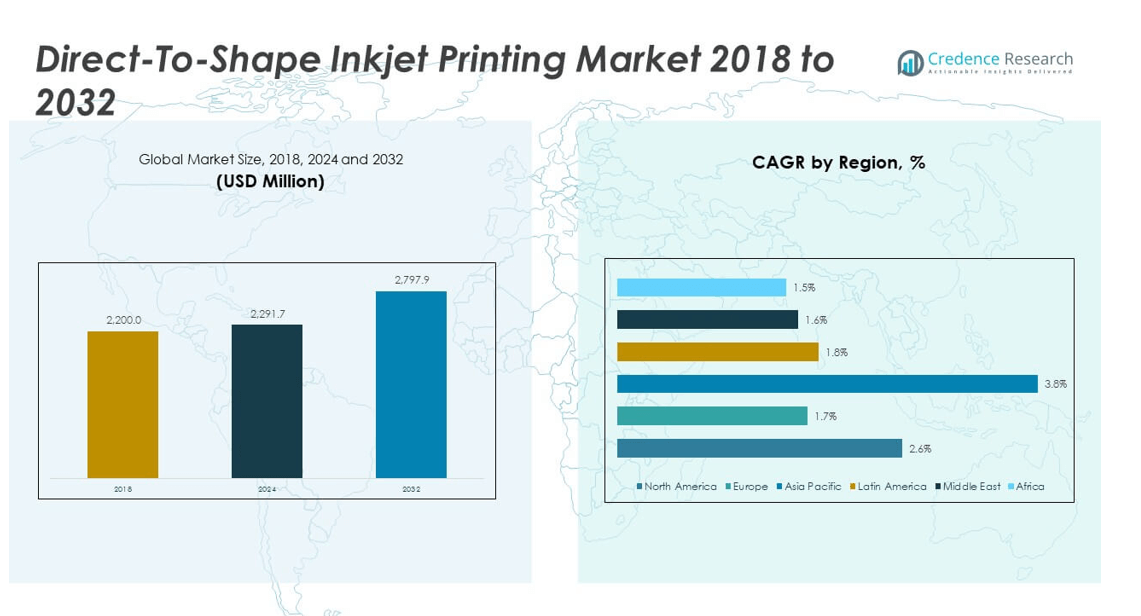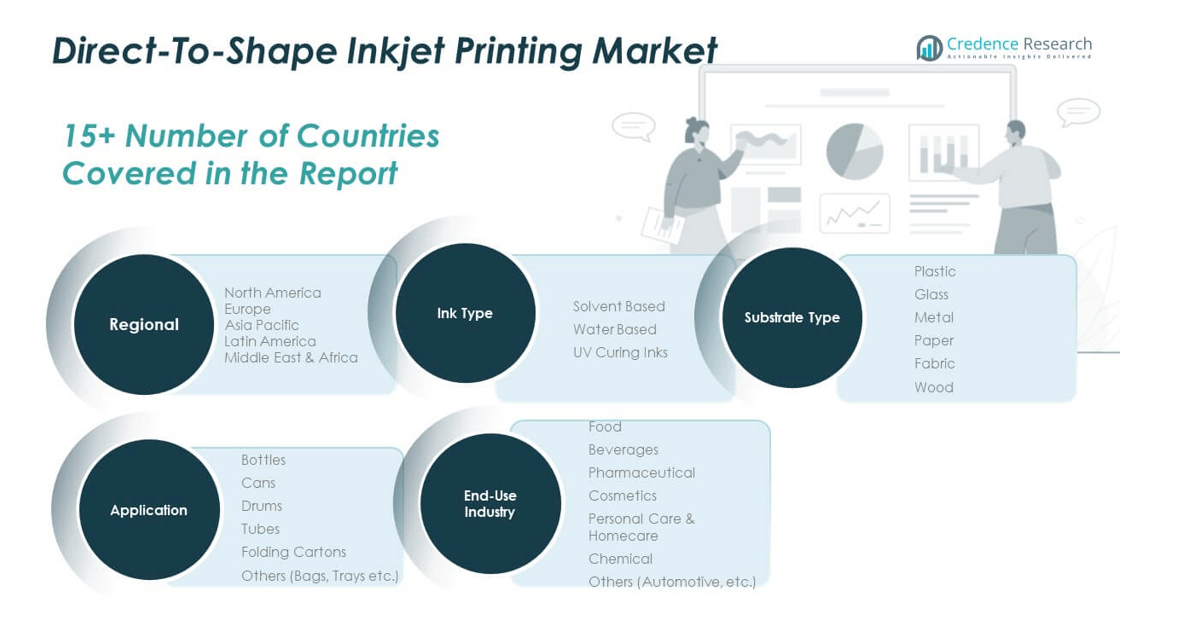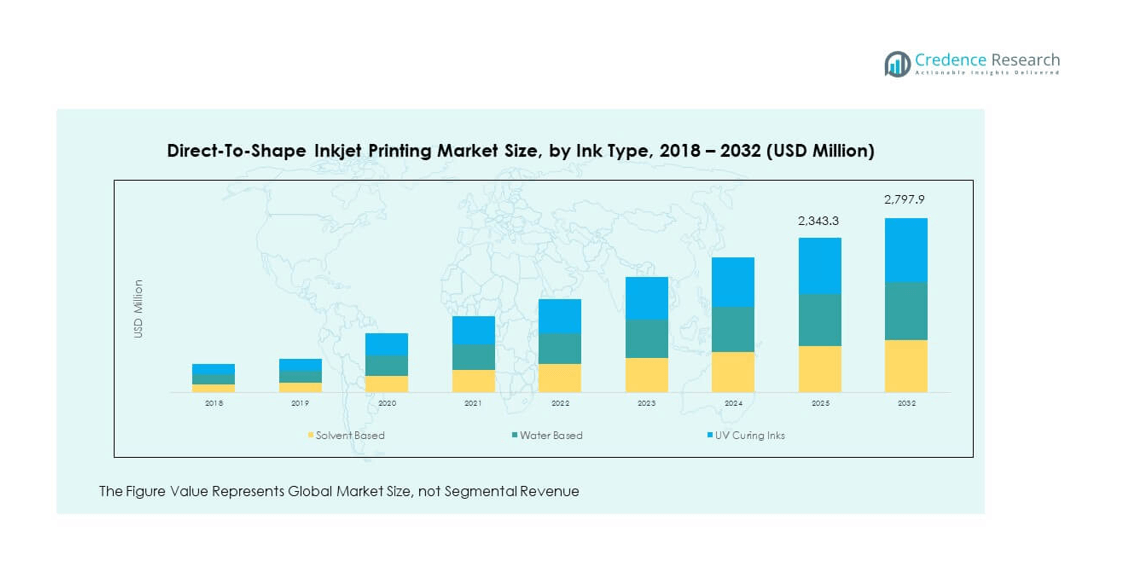CHAPTER NO. 1 : GENESIS OF THE MARKET
1.1 Market Prelude – Introduction & Scope
1.2 The Big Picture – Objectives & Vision
1.3 Strategic Edge – Unique Value Proposition
1.4 Stakeholder Compass – Key Beneficiaries
CHAPTER NO. 2 : EXECUTIVE LENS
2.1 Pulse of the Industry – Market Snapshot
2.2 Growth Arc – Revenue Projections (USD Million)
2.3. Premium Insights – Based on Primary Interviews
CHAPTER NO. 3 : DIRECT-TO-SHAPE INKJET PRINTING MARKET FORCES & INDUSTRY PULSE
3.1 Foundations of Change – Market Overview
3.2 Catalysts of Expansion – Key Market Drivers
3.2.1 Momentum Boosters – Growth Triggers
3.2.2 Innovation Fuel – Disruptive Technologies
3.3 Headwinds & Crosswinds – Market Restraints
3.3.1 Regulatory Tides – Compliance Challenges
3.3.2 Economic Frictions – Inflationary Pressures
3.4 Untapped Horizons – Growth Potential & Opportunities
3.5 Strategic Navigation – Industry Frameworks
3.5.1 Market Equilibrium – Porter’s Five Forces
3.5.2 Ecosystem Dynamics – Value Chain Analysis
3.5.3 Macro Forces – PESTEL Breakdown
3.6 Price Trend Analysis
3.6.1 Regional Price Trend
3.6.2 Price Trend by product
CHAPTER NO. 4 : KEY INVESTMENT EPICENTER
4.1 Regional Goldmines – High-Growth Geographies
4.2 Product Frontiers – Lucrative Product Categories
4.3 Substrate Type Sweet Spots – Emerging Demand Segments
CHAPTER NO. 5: REVENUE TRAJECTORY & WEALTH MAPPING
5.1 Momentum Metrics – Forecast & Growth Curves
5.2 Regional Revenue Footprint – Market Share Insights
5.3 Segmental Wealth Flow – Ink Type & Substrate Type Revenue
CHAPTER NO. 6 : TRADE & COMMERCE ANALYSIS
6.1. Import Analysis by Region
6.1.1. Global Direct-To-Shape Inkjet Printing Market Import Revenue By Region
6.2. Export Analysis by Region
6.2.1. Global Direct-To-Shape Inkjet Printing Market Export Revenue By Region
CHAPTER NO. 7 : COMPETITION ANALYSIS
7.1. Company Market Share Analysis
7.1.1. Global Direct-To-Shape Inkjet Printing Market: Company Market Share
7.2. Global Direct-To-Shape Inkjet Printing Market Company Revenue Market Share
7.3. Strategic Developments
7.3.1. Acquisitions & Mergers
7.3.2. New Product Launch
7.3.3. Regional Expansion
7.4. Competitive Dashboard
7.5. Company Assessment Metrics, 2024
CHAPTER NO. 8 : DIRECT-TO-SHAPE INKJET PRINTING MARKET – BY INK TYPE SEGMENT ANALYSIS
8.1. Direct-To-Shape Inkjet Printing Market Overview by Ink Type Segment
8.1.1. Direct-To-Shape Inkjet Printing Market Revenue Share By Ink Type
8.2. Solvent Based
8.3. Water Based
8.4. UV Curing Inks
CHAPTER NO. 9 : DIRECT-TO-SHAPE INKJET PRINTING MARKET – BY SUBSTRATE TYPE SEGMENT ANALYSIS
9.1. Direct-To-Shape Inkjet Printing Market Overview by Substrate Type Segment
9.1.1. Direct-To-Shape Inkjet Printing Market Revenue Share By Substrate Type
9.2. Plastic
9.3. Glass
9.4. Metal
9.5. Paper
9.6. Fabric
9.7. Wood
CHAPTER NO. 10 : DIRECT-TO-SHAPE INKJET PRINTING MARKET – BY MOUNTING STYLE SEGMENT ANALYSIS
10.1. Direct-To-Shape Inkjet Printing Market Overview by Mounting Style Segment
10.1.1. Direct-To-Shape Inkjet Printing Market Revenue Share By Mounting Style
10.2. Bottles
10.3. Cans
10.4. Drums
10.5. Tubes
10.6. Folding Cartons
10.7. Others (Bags, Trays etc.)
CHAPTER NO. 11 : DIRECT-TO-SHAPE INKJET PRINTING MARKET – BY END‑USE INDUSTRY SEGMENT ANALYSIS
11.1. Direct-To-Shape Inkjet Printing Market Overview by End‑Use Industry Segment
11.1.1. Direct-To-Shape Inkjet Printing Market Revenue Share By End‑Use Industry
11.2. Food
11.3. Beverages
11.4. Pharmaceutical
11.5. Cosmetics
11.6. Personal Care & Homecare
11.7. Chemical
11.8. Others (Automotive, etc.)
CHAPTER NO. 12 : DIRECT-TO-SHAPE INKJET PRINTING MARKET – REGIONAL ANALYSIS
12.1. Direct-To-Shape Inkjet Printing Market Overview by Region Segment
12.1.1. Global Direct-To-Shape Inkjet Printing Market Revenue Share By Region
12.1.2. Regions
12.1.3. Global Direct-To-Shape Inkjet Printing Market Revenue By Region
12.1.4. Ink Type
12.1.5. Global Direct-To-Shape Inkjet Printing Market Revenue By Ink Type
12.1.6. Substrate Type
12.1.7. Global Direct-To-Shape Inkjet Printing Market Revenue By Substrate Type
12.1.8. Mounting Style
12.1.9. Global Direct-To-Shape Inkjet Printing Market Revenue By Mounting Style
12.1.10. End‑Use Industry
12.1.11. Global Direct-To-Shape Inkjet Printing Market Revenue By End‑Use Industry
CHAPTER NO. 13 : NORTH AMERICA DIRECT-TO-SHAPE INKJET PRINTING MARKET – COUNTRY ANALYSIS
13.1. North America Direct-To-Shape Inkjet Printing Market Overview by Country Segment
13.1.1. North America Direct-To-Shape Inkjet Printing Market Revenue Share By Region
13.2. North America
13.2.1. North America Direct-To-Shape Inkjet Printing Market Revenue By Country
13.2.2. Ink Type
13.2.3. North America Direct-To-Shape Inkjet Printing Market Revenue By Ink Type
13.2.4. Substrate Type
13.2.5. North America Direct-To-Shape Inkjet Printing Market Revenue By Substrate Type
13.2.6. Mounting Style
13.2.7. North America Direct-To-Shape Inkjet Printing Market Revenue By Mounting Style
13.2.8. End‑Use Industry
13.2.9. North America Direct-To-Shape Inkjet Printing Market Revenue By End‑Use Industry
13.3. U.S.
13.4. Canada
13.5. Mexico
CHAPTER NO. 14 : EUROPE DIRECT-TO-SHAPE INKJET PRINTING MARKET – COUNTRY ANALYSIS
14.1. Europe Direct-To-Shape Inkjet Printing Market Overview by Country Segment
14.1.1. Europe Direct-To-Shape Inkjet Printing Market Revenue Share By Region
14.2. Europe
14.2.1. Europe Direct-To-Shape Inkjet Printing Market Revenue By Country
14.2.2. Ink Type
14.2.3. Europe Direct-To-Shape Inkjet Printing Market Revenue By Ink Type
14.2.4. Substrate Type
14.2.5. Europe Direct-To-Shape Inkjet Printing Market Revenue By Substrate Type
14.2.6. Mounting Style
14.2.7. Europe Direct-To-Shape Inkjet Printing Market Revenue By Mounting Style
14.2.8. End‑Use Industry
14.2.9. Europe Direct-To-Shape Inkjet Printing Market Revenue By End‑Use Industry
14.3. UK
14.4. France
14.5. Germany
14.6. Italy
14.7. Spain
14.8. Russia
14.9. Rest of Europe
CHAPTER NO. 15 : ASIA PACIFIC DIRECT-TO-SHAPE INKJET PRINTING MARKET – COUNTRY ANALYSIS
15.1. Asia Pacific Direct-To-Shape Inkjet Printing Market Overview by Country Segment
15.1.1. Asia Pacific Direct-To-Shape Inkjet Printing Market Revenue Share By Region
15.2. Asia Pacific
15.2.1. Asia Pacific Direct-To-Shape Inkjet Printing Market Revenue By Country
15.2.2. Ink Type
15.2.3. Asia Pacific Direct-To-Shape Inkjet Printing Market Revenue By Ink Type
15.2.4. Substrate Type
15.2.5. Asia Pacific Direct-To-Shape Inkjet Printing Market Revenue By Substrate Type
15.2.6. Mounting Style
15.2.7. Asia Pacific Direct-To-Shape Inkjet Printing Market Revenue By Mounting Style
15.2.8. End‑Use Industry
15.2.9. Asia Pacific Direct-To-Shape Inkjet Printing Market Revenue By End‑Use Industry
15.3. China
15.4. Japan
15.5. South Korea
15.6. India
15.7. Australia
15.8. Southeast Asia
15.9. Rest of Asia Pacific
CHAPTER NO. 16 : LATIN AMERICA DIRECT-TO-SHAPE INKJET PRINTING MARKET – COUNTRY ANALYSIS
16.1. Latin America Direct-To-Shape Inkjet Printing Market Overview by Country Segment
16.1.1. Latin America Direct-To-Shape Inkjet Printing Market Revenue Share By Region
16.2. Latin America
16.2.1. Latin America Direct-To-Shape Inkjet Printing Market Revenue By Country
16.2.2. Ink Type
16.2.3. Latin America Direct-To-Shape Inkjet Printing Market Revenue By Ink Type
16.2.4. Substrate Type
16.2.5. Latin America Direct-To-Shape Inkjet Printing Market Revenue By Substrate Type
16.2.6. Mounting Style
16.2.7. Latin America Direct-To-Shape Inkjet Printing Market Revenue By Mounting Style
16.2.8. End‑Use Industry
16.2.9. Latin America Direct-To-Shape Inkjet Printing Market Revenue By End‑Use Industry
16.3. Brazil
16.4. Argentina
16.5. Rest of Latin America
CHAPTER NO. 17 : MIDDLE EAST DIRECT-TO-SHAPE INKJET PRINTING MARKET – COUNTRY ANALYSIS
17.1. Middle East Direct-To-Shape Inkjet Printing Market Overview by Country Segment
17.1.1. Middle East Direct-To-Shape Inkjet Printing Market Revenue Share By Region
17.2. Middle East
17.2.1. Middle East Direct-To-Shape Inkjet Printing Market Revenue By Country
17.2.2. Ink Type
17.2.3. Middle East Direct-To-Shape Inkjet Printing Market Revenue By Ink Type
17.2.4. Substrate Type
17.2.5. Middle East Direct-To-Shape Inkjet Printing Market Revenue By Substrate Type
17.2.6. Mounting Style
17.2.7. Middle East Direct-To-Shape Inkjet Printing Market Revenue By Mounting Style
17.2.8. End‑Use Industry
17.2.9. Middle East Direct-To-Shape Inkjet Printing Market Revenue By End‑Use Industry
17.3. GCC Countries
17.4. Israel
17.5. Turkey
17.6. Rest of Middle East
CHAPTER NO. 18 : AFRICA DIRECT-TO-SHAPE INKJET PRINTING MARKET – COUNTRY ANALYSIS
18.1. Africa Direct-To-Shape Inkjet Printing Market Overview by Country Segment
18.1.1. Africa Direct-To-Shape Inkjet Printing Market Revenue Share By Region
18.2. Africa
18.2.1. Africa Direct-To-Shape Inkjet Printing Market Revenue By Country
18.2.2. Ink Type
18.2.3. Africa Direct-To-Shape Inkjet Printing Market Revenue By Ink Type
18.2.4. Substrate Type
18.2.5. Africa Direct-To-Shape Inkjet Printing Market Revenue By Substrate Type
18.2.6. Mounting Style
18.2.7. Africa Direct-To-Shape Inkjet Printing Market Revenue By Mounting Style
18.2.8. End‑Use Industry
18.2.9. Africa Direct-To-Shape Inkjet Printing Market Revenue By End‑Use Industry
18.3. South Africa
18.4. Egypt
18.5. Rest of Africa
CHAPTER NO. 19 : COMPANY PROFILES
19.1. Azonprinter d.o.o.
19.1.1. Company Overview
19.1.2. Product Portfolio
19.1.3. Financial Overview
19.1.4. Recent Developments
19.1.5. Growth Strategy
19.1.6. SWOT Analysis
19.2. DMPS CO.LTD.
19.3. Epson America, Inc.
19.4. Heidelberg USA, Inc.
19.5. INX International Ink Co.
19.6. Koenig & Bauer AG
19.7. LogoJET
19.8. Mimaki Europe B.V.
19.9. Roland DG Corporation
19.10. Sun 3D Corporation
19.11. Tonejet Limited
19.12. Velox Ltd.
19.13. Xerox Corporation










